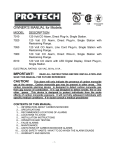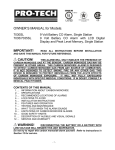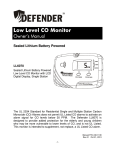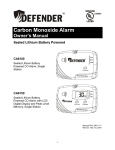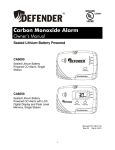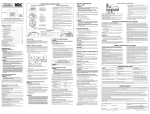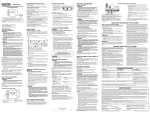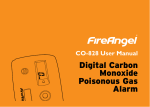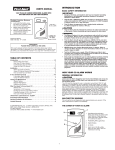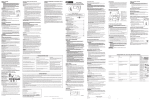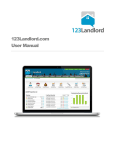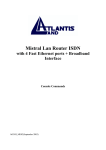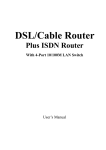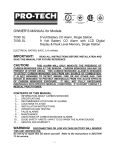Download Commercial CO Monitor
Transcript
8505 Battery Powered Commercial CO Monitor OWNER’S MANUAL IMPORTANT! READ ALL INSTRUCTIONS BEFORE INSTALLATION AND SAVE THIS MANUAL FOR FUTURE REFERENCE CAUTION! THIS MONITOR WILL ONLY INDICATE THE PRESENCE OF CARBON MONOXIDE GAS AT THE SENSOR. CARBON MONOXIDE GAS MAY BE PRESENT IN OTHER AREAS. THIS CARBON MONOXIDE MONITOR IS DESIGNED TO DETECT CARBON MONOXIDE GAS FROM ANY SOURCE OF COMBUSTION. IT IS NOT DESIGNED TO DETECT SMOKE, FIRE OR ANY OTHER GAS. TABLE OF CONTENTS 1…. 2…. 3…. 4…. 5…. 6…. 7…. 8…. 9…. 10…. 11…. 12…. INFORMATION ABOUT CARBON MONOXIDE CO MONITOR FEATURES & SPECIFICATIONS RECOMMENDED LOCATIONS OF CO MONITORS LOCATIONS TO AVOID INSTALLATION INSTRUCTIONS OPERATION AND TESTING WARNING MAINTENANCE LIMITATIONS OF CARBON MONOXIDE MONITORS GOOD SAFETY HABITS / WHAT TO DO WHEN THE MONITOR SOUNDS DESCRIPTION OF AUDIBLE AND VISUAL SIGNALS SERVICE AND WARRANTY WARNING! A DISCONNECTED OR LOW VOLTAGE BATTERY WILL RENDER THIS UNIT INOPERATIVE. Do not try to repair this CO monitor yourself. Refer to the instructions in SECTION 12 for service. The UL 2034 Standard for Residential Carbon Monoxide (CO) Alarms does not permit UL Listed CO alarms to activate an alarm signal below 30 PPM CO. The Pro-Tech 8505 provides visual signals at 10 PPM and audible and visual alarm signals at 20 PPM, and is not UL Listed. This monitor is intended for commercial applications. 1 1. INFORMATION ABOUT CARBON MONOXIDE WHAT IS CARBON MONOXIDE? Carbon monoxide (CO) is a highly toxic, invisible, odorless, tasteless gas. HOW IS CO GENERATED? Carbon monoxide is a byproduct of the incomplete combustion of fuel. Faulty ventilation of furnaces, boilers, water heaters, kitchen appliances, and space heaters are a major of cause of high CO levels in a building. Automobile, forklift and small engine exhaust are another potential source of CO. HOW DOES CO POISON PEOPLE? The human body depends on oxygen for the burning of fuel (food) to provide us with the energy that allows our cells to live and function. Oxygen makes up approximately 21% of the atmosphere and enters our lungs when we breathe. In our lungs the oxygen combines with the hemoglobin in the blood (oxyhemoglobin) and is carried in the blood stream throughout the body where it releases oxygen to the cells. Carbon monoxide is dangerous because it bonds more tightly to the hemoglobin (carboxyhemoglobin, COHb) than oxygen does. When CO combines with hemoglobin, the hemoglobin's ability to combine with oxygen is lost. As the COHb concentration rises, people become nauseous, unconscious and ultimately die (see below). WHAT ARE THE SYMPTOMS OF CARBON MONOXIDE POISONING? Many people often confuse carbon monoxide poisoning with the flu; the initial symptoms being very similar. Different concentrations of CO over various lengths of time cause different symptoms. Many cases of carbon monoxide poisoning indicate that while the victims were aware that they were not well, they were too disoriented to save themselves by either calling for assistance or exiting the building. Also, due to size, small children and pets are generally the first affected. The following are the symptoms related to CARBON MONOXIDE POISONING. Discuss them with all persons that may be affected. MILD EXPOSURE: MEDIUM EXPOSURE: EXTREME EXPOSURE: Slight headaches, nausea, vomiting, running nose, sore eyes, fatigue (often described as “Flu-like” symptoms). Severe throbbing headache, dizziness, drowsiness, confusion, fast heart rate. Unconsciousness, convulsions, cardiorespiratory failure, brain damage, death. 2 2. CO MONITOR FEATURES Battery Powered Commercial CO Monitor Accurate and Reliable Electrochemical Sensor Integrated Filter for Removing Nuisance Gases Samples for Carbon Monoxide Every Second Alpha Numeric LCD Readout with “Smart” Back Light Continuous Display of Current CO Levels Detected from 10 to 999 PPM Records and Displays Peak CO Level with Duration and When Occurred Calculates and Displays 8-Hour Time-Weighted Average (TWA) Concentration Stores 30 Days of Data Audible and Visual Alarm Signals Self Diagnostic Circuitry and Sensor Life Monitor Complies with ACGIH, Cal/OSHA, NIOSH, and OSHA Workplace Exposure Limits One Year Limited Factory Warranty Smart Backlight CO value in PPM Alpha Numeric LCD Display Alpha Numeric LCD Display Power Indicator A B C D E Alarm Indicator H F G POWER ALARM Test/Reset/Mute Button CO LEVEL (PPM) TEST RESET MUTE COM ME R C I AL CARBON MONOXIDE M O N I T O R Display Memory Button DISPLAY MEMORY A. PEAK Highest CO level detected B. TWA Average CO level detected for previous 8 hours C. FOR Duration of Peak CO in Hr. and Min. D. WHEN E. Day Style White Housing How long ago Peak detected, in Day, Hr, and Min. Hr Min For how long or how long ago event occurred F. Low Battery Voltage icon G. Muted Alarm icon Loud Piercing Alarm Electrochemical Sensor Battery Compartment in Back 3 H1. 3-digit display for CO level and event timing H2. Monitor malfunction signal. Service required H3. End of sensor life signal. Replace monitor H4. Monitor’s memory has been cleared SPECIFICATIONS - Commercial Carbon Monoxide Monitor - Battery Powered: 9VDC Sensor Type: electrochemical Sample Frequency: every second Display: continual LCD readout of CO levels detected from 10-999ppm Display Resolution: 1ppm Display Accuracy: +/-5% or 5ppm, whichever is greater* TLV alarm time: 20 ppm ≤ 7 hrs REL alarm time: 30 ppm ≤ 3 hrs PEL alarm time: 45 ppm ≤ 90 minutes STEL alarm time: 190 ppm ≤ 5 minutes Peak Level Memory: records actual peak CO level detected, duration, and when occurred Peak Level Memory History: prior 30 days Time-Weighted Average (TWA): calculates average CO concentration for prior 8 hours Display Backlight: automatic for alarm, manual for memory and testing functions Power On Signal: flashing green LED Audible Alarm Signal: 85dB at 10 feet; 4 short beeps every 5 seconds for 5 minutes, and thereafter 4 short beeps every minute Visual Alarm Signal: Red LED flashes in sync with audible alarm signal Mute Button: silences audible signal for up to 5 minutes, green LED blinks once/min Test Functions: self diagnostic circuitry and manual test button Low Battery Signal: low battery icon, green LED blinks once/min, one chirp/min - Malfunction Signal: displays - , red LED blinks twice/min, two chirps/min Sensor Expiration Signal: displays , red LED blinks twice/min, one chirp/min Storage Temperature and Humidity: 30°F to 120°F @ 30% ~ 95% RH Operating Temperature and Humidity: 40°F to 100°F @ 10% ~ 90% RH Unit Weight: 8 oz w/battery Unit Dimensions: 5-9/16"h x 3-7/16"w x 1-5/16"d Color: White Life Expectancy: Two years Warranty: One year limited warranty * The accuracy of the display is an estimate for the first year only. The accuracy may also be affected by environmental conditions and other circumstances beyond manufacturer's control. This fixed CO monitor is designed to activate audible and visual alarm signals before the immediate area reaches the Threshold Limit (TLV), Recommended (REL), or Permissible (PEL) Time Weighted Average (TWA) carbon monoxide exposure limits established by the American Conference of Governmental Industrial Hygienists (ACGIH), National Institute for Occupational Safety and Health (NIOSH), and Occupational Safety and Health Administration (OSHA). Workers who are known to be at high risk to CO exposure should also wear personal gas monitors. 4 3. RECOMMENDED LOCATION OF CO MONITORS: CO poisoning can happen anywhere in a building. At the minimum, CO monitors should be located on every level of the building, near the persons who may be potentially affected by CO poisoning, and where workers can hear any alarm. More than one CO monitor may be required within different areas of the building. A space which contains fuel burning equipment, and areas and rooms adjacent to this space or any parking garage, should also have a CO monitor installed. If the monitor is installed in a hallway and any office doors are kept closed, install a CO monitor in each of these rooms. If the monitor is installed in a large open area, one monitor should be installed for every 1000 square feet of vertically unobstructed space. A monitor should also be installed near each exit from the building to alert employees of a CO alarm condition prior to entering. Mount CO monitors onto an interior wall about three inches above eye level for the best view of the display readout. CO detection is best achieved by installing monitors in all rooms and areas of building. DO NOT install monitor within 5 feet of combustion equipment. DO NOT install monitor on any exterior wall, or within 1 foot of exterior door or window. Conditions which can result in CO production or exposure: 1) Excessive spillage or reverse venting of fuel burning appliances caused by outdoor ambient conditions, such as: i) Wind direction and/or velocity, including high gusts of wind. Heavy air in the vent pipes (cold/humid air with extended periods between cycles). ii) Negative pressure differential resulting from the use of exhaust fans. iii) Several fuel burning appliances competing for limited internal air. iv) Vent pipe connections vibrating loose from furnaces, boilers or water heaters. v) Obstructions or unconventional vent designs which amplify the above situations. vi) Poorly designed or maintained chimneys and/or vents. 2) Extended operation of unvented fuel burning devices. 3) Temperature inversions which can trap exhaust gases near the ground. 4) Truck, car or forklift operating or idling in an open or closed attached garage or warehouse, or near a building. 4. WARNING! LOCATIONS TO AVOID: NEAR COOKING APPLIANCES: To avoid nuisance alarms and grease build up, which may cause monitor failure, do not install monitor within five feet of cooking appliances. WITHIN FIVE FEET OF FURNACE, BOILER, SPACE HEATER, OR WATER HEATER: These devices often spill out CO when they first turn on. IN DUSTY AREAS: Dust can build up on the monitor and cause failure to alarm. IN CLEANING SUPPLY ROOMS: Cleaning chemicals and painting supplies may cause nuisance alarms. IN VERY HOT OR COLD AREAS: Do not install the monitor onto an exterior wall, or in unconditioned spaces or areas which are below 40oF (4.4°C) or above 100oF (37.8°C). IN HAZARDOUS LOCATIONS: This monitor is not suitable for installation in a hazardous location, as defined in the National Electrical Code. 5 5. INSTALLATION INSTRUCTIONS: NOTE: REVIEW SECTION 3, RECOMMENDED LOCATIONS OF CO MONITOR AND SECTION 4, LOCATIONS TO AVOID, PRIOR TO INSTALLING YOUR CO MONITOR. The proper power for the Pro-Tech 8505 commercial CO monitor is a 9V battery. Constant exposure to high or low temperatures or humidity may reduce battery life. BATTERY INSTALLATION AND REPLACEMENT: Slide down and remove battery door, and attach a new 9 Volt alkaline battery to the battery cable. Battery must snap firmly onto both connectors. Use an Ultralife U9VL-J lithium battery for a longer life. Place the battery in the battery compartment, and slide the battery door upward and over the compartment until the door latches firmly in place. Press the TEST/RESET/MUTE button to verify activation. (See TESTING in section 6) MOUNTING INSTRUCTIONS: After selecting the proper location as described in SECTION 3, drive one screw into the wall about three inches above eye level, and an optional second screw 3 to 3⅛ inches directly below it. Leave the screw-heads about ¼ inch out from the wall. Hang monitor onto the top screw-head and gently pull down to secure. Slide bottom of monitor from right to left until it seats firmly onto the lower screw, if installed. After installation, TEST your CO monitor by pressing the TEST/RESET/MUTE button for two seconds. Complete instructions regarding testing are outlined in SECTION 6. Be sure that the monitor is not obstructed by furniture, equipment, etc. 6. OPERATION, TESTING: OPERATION: The CO monitor is operational once a battery is installed. A 3 minute start-up test will display all words, numbers and symbols , and flash the green LED every second. When the test is complete, the display should read 0ppm and green LED blink once per minute. LOW BATTERY CONDITION: When the battery voltage drops below an acceptable level, the monitor will chirp once per minute, the green LED will blink once per minute, and the low battery voltage symbol will appear on the LCD display. Replace the battery immediately in order to provide uninterrupted protection. Please see SECTION 5 for information regarding battery replacement. SERVICE CONDITION: The internal microcontroller continuously monitors the sensor and other critical components. If an internal failure of any of these components should occur, the CO monitor will double chirp once per minute, the red LED will blink twice per minute, and 6 will appear on the LCD display. The trouble condition indicates a problem with the unit, and it will not alarm if exposed to CO. See SECTION 12 for service information. SENSOR LIFE MONITOR: The electrochemical sensor has a life expectancy of 2 years, however, the monitor’s CO readings will decrease in accuracy after the first year. A microcontroller counts the total time that the CO monitor is under power. After 2 years, the “Sensor End-of-Life” signal will activate, indicating that the sensor life has expired. The CO monitor will chirp once per minute, the red LED will blink once per minute, and will appear on the LCD display. When the sensor life expires, the monitor may still work for a period of time, but it may not alarm when exposed to CO. It is recommended that you replace the monitor annually, but, once the sensor life expires, you must replace the monitor immediately. ALARM CONDITION: When CO gas is detected at a level and duration specified in SECTION 2, the monitor will alarm and the red LED will flash. The monitor will display the current CO level detected, sound 4 short beeps every 5 seconds for 5 minutes, and thereafter 4 short beeps every minute until the TEST/RESET/MUTE button is pressed and the CO level detected drops below 20ppm. DISPLAY PEAK CO EXPOSURE RECORD: To manually display the highest CO level detected, press the DISPLAY MEMORY button for 2 seconds. The LCD will display the recorded data in the following order: 1. The highest (peak) CO level detected within last 30 days from 10 to 999 PPM. 2. The total length of time, in hours and minutes, the highest CO level was detected over last 30 days, including levels within 10% of the peak. 3. How many days, hours and minutes ago a CO level within 10% of the peak was last detected. 4. The Time Weighted Average (TWA) concentration of CO detected over the previous 8 hours. The monitor maintains the 30 most recent days of peak CO level history, and the most recent TWA value. To manually erase the record, press the DISPLAY MEMORY button once, and while the readings are being displayed, press TEST/RESET/MUTE button once. The monitor will sound one short beep and will appear on the LCD display. Disconnecting the battery will not erase memory. TESTING: To test your monitor, press the TEST/RESET/MUTE button for 2 seconds. The red LED will flash and the monitor's horn will beep 4 times, remain silent 5 seconds, then beep 4 times again if horn and electronic circuitry are working properly. The current CO level 7 detected will be displayed. If the unit is already in the “service” condition, the monitor will double beep and display , and must be serviced immediately. LCD DISPLAY FUNCTION: In normal operation, the LCD screen will display the current CO level detected from 10 to 999ppm, and update the detected value every 1 second. The number 0ppm will be displayed if less than 10ppm CO is detected. The display accuracy may be affected by environmental conditions and other circumstances beyond manufacturer's control. LCD BACKLIGHT FUNCTION: In normal operation, the LCD backlight is turned off to preserve battery life. The backlight will automatically turn on for 5 minutes when alarm is activated. The backlight will also turn on when the TEST/RESET/MUTE button is pressed to test the monitor, or the DISPLAY MEMORY button is pressed to read the peak CO level and TWA record. The backlight will automatically turn off when the TEST or DISPLAY MEMORY functions are completed. DO NOT TRY TO TEST THIS CO MONITOR IN ANY OTHER WAY. If no alarm sounds during a test, check battery power. If monitor still does not sound, the unit may be malfunctioning and should be returned for service (SEE SECTION 12). TEST THE CO MONITOR WEEKLY TO ENSURE PROPER OPERATION. Erratic or low sound coming from your CO monitor may indicate a malfunctioning unit, and it should be returned for service (SEE SECTION 12). RESET/MUTE: Once the CO monitor activates an alarm, it will not automatically reset/mute itself. Press the TEST/RESET/MUTE button once to temporarily silence the monitor for 5 minutes. The muted alarm symbol will be displayed, the red LED will blink 4 times per minute, and the current CO level will be displayed. If the monitor continues to detect CO levels of 20ppm or more, the audible and visual alarm signals will automatically reactivate within 5 minutes. If the CO level drops below 20ppm, the alarm signals will not reactivate. 7. WARNING: Carbon monoxide monitors respond to the presence of CO. They do not detect smoke. IF YOU HAVE BEEN AWAY FROM THE BUILDING AND RETURN TO FIND THE ALARM(S) SOUNDING, DO NOT ENTER THE BUILDING. CALL THE FIRE DEPARTMENT FROM ANOTHER LOCATION. DO NOT RE-ENTER BUILDING FOR ANY REASON UNTIL YOU HAVE BEEN ASSURED THAT IT IS SAFE TO DO SO. 8. MAINTENANCE: CLEANING YOUR MONITOR You can clean your CO monitor by using a vacuum cleaner brush to vacuum around the openings on the CO monitor. The outside of the CO monitor can be wiped with a soft cloth slightly dampened with water only. 8 AFTER CLEANING, TEST YOUR CO MONITOR TO MAKE SURE THAT IT IS WORKING PROPERLY. DO NOT PAINT ON OR NEAR THE ALARM: The paint will block the vents and affect the alarm function. DO NOT SPRAY AIR REFRESHENER, CLEANING SUPPLIES, OR INSECT KILLER ON OR NEAR THE ALARM: Certain kinds of aerosol chemicals will damage the sensor and cause improper operation. The area must be well ventilated when using cleaning supplies or similar contaminants. 9 9. LIMITATIONS OF CARBON MONOXIDE MONITORS Carbon monoxide monitors are devices that can provide an early warning of the presence of CO gas at a reasonable cost. However, monitors have sensing limitations and may not always sound a warning in the presence of CO. The monitor will not operate if the battery power is low or dead. CO monitors must be tested regularly to ensure that they are receiving power and operating properly. Carbon monoxide monitors cannot sense CO that does not reach the monitor, and therefore CO monitors may not detect CO which is in another area of the building. Furthermore, if the CO monitor is located on a different level of the building or on the other side of a closed door, it may not alert everyone at risk. The use of drugs and alcohol may impair ones ability to hear the alarm. If you have a multi-level building, install CO monitors on each level. If the monitor is installed in a hallway and any office doors are kept closed, install a CO monitor in each room. If the monitor is installed in a large open area, one monitor should be installed for every 1000 square feet of vertically unobstructed space. Although CO monitors can help save lives by providing an early warning to the presence of carbon monoxide, they are not a substitute for an insurance policy. Property owners, leaseholders and renters should have adequate insurance to protect everyone’s health, lives and property. 10. GOOD SAFETY HABITS: DEVELOP AND PRACTICE A PLAN OF ESCAPE: Make a floor plan indicating all doors and windows and at least two escape routes from each room. Second story and higher windows may need fire escape built to local code. Have a meeting to discuss your escape plan, and show everyone what to do in case an alarm sounds. Determine a place outside the building where you can all meet if an alarm occurs. Familiarize everyone with the sound of the alarm and train them to leave the building when they hear it. Practice a CO and fire drill at least once every six months. Practice allows you to test your plan before an emergency. You may not be able to reach everyone. It is important that they all know what to do. WHAT TO DO WHEN THE ALARM SOUNDS: If alarm signal sounds (the red LED will flash and the alarm will sound 4 short beeps every 5 seconds): 1) Operate TEST/RESET/MUTE button to temporarily silence alarm; 2) Immediately move to fresh air - outdoors or by an open door or window. Check that all persons are accounted for. Do not re-enter the premises or move away from the open door/window until the premises have been aired out, and your monitor remains in its normal condition; 3) After following steps 1 and 2, if the alarm reactivates within a 24 hour period, repeat steps 1 and 2 and call a qualified appliance technician, if you have not already. Fuel burning equipment, appliances and vehicles must be inspected for proper operation, and the source of CO must be investigated. If problems are identified during this inspection, have the equipment serviced immediately. Note any combustion equipment not inspected by the technician, and consult the manufacturers' instructions, or contact the manufacturers directly, for more information about CO safety and this equipment. Make sure that motor vehicles or forklifts are not, and have not been, operating in an attached garage or warehouse, or adjacent to the building. 10 11. AUDIBLE AND VISUAL SIGNALS Condition LCD Readout LEDs Horn Normal Operation Displays “0ppm” continuously. Backlight is OFF Green LED blinks once every minute Silent Alarm Activation Displays current CO reading in PPM. Backlight turns ON for 5 minutes, and thereafter in sync with beeping Red LED flashes 4 times every 5 seconds in synchronous with horn Beeps 4 times, pauses for 4 seconds. Repeats this pattern for first 5 minutes. Then pause time increases to 1 minute Mute Alarm Audible Signal Displays “ ”, and current CO reading in PPM. Backlight is OFF Green LED blinks once per minute; red LED blinks 4 times per minute Silent Red LED flash in synchronous with horn Beeps 4 times, pauses for 5 seconds, beeps 4 times Testing Alarm Recall Peak CO Level Displays current CO level detected. Backlight is ON while in testing sequence Displays the highest CO level detected within last 30 days from 10 to 999 PPM, The total length of time the highest CO level was detected over last 30 days, including levels within 10% of the peak, How long ago a CO level within 10% of the peak was last detected, and Green and red LED are OFF while displaying the peak record. Silent while displaying the peak record The Time Weighted Average (TWA) concentration of CO detected over the previous 8 hours. Clear Peak Record Displays cleared Green and red LED are OFF One short beep when record is cleared Low Battery Power Displays “ ” and current CO reading in PPM Green LED blinks once per minute Chirps once per minute “End-of-Life” Displays Red LED flashes once per minute Chirps once per minute Trouble/Service Displays Red LED blinks twice per minute Chirps twice per minute when record is 11 12. SERVICE AND WARRANTY: IMPORTANT! SAFETY INSTRUCTIONS: In the event of any malfunctions with the monitor, do not attempt to repair the unit. This product should be serviced by a qualified service technician. Return the monitor for service to the address listed below. ONE-YEAR LIMITED WARRANTY The manufacturer, PPI, warrants to the original end-user purchaser that this commercial CO monitor shall be free from defects in materials and workmanship from the date of purchase for one year. If this CO monitor is determined to be defective in original materials or workmanship during the warranty period, return the monitor to the address indicated below with delivery costs prepaid. Do not attempt to repair this product yourself. If determined to be defective in original materials or workmanship, the CO monitor will be repaired or replaced, at the sole discretion of the manufacturer. This warranty does not cover normal wear of parts or damage resulting from any of the following: improper storage, negligent use or misuse of the product, use contrary to the operating instructions, operation in unconditioned space (below 40°F or above 100°F), disassembly, or repair or alteration by anyone other than the manufacturer or an authorized service center. Further, the warranty does not cover acts of God, such as fire, flood, earthquakes, hurricanes and tornadoes. The liability of the manufacturer, or of any of its parent or subsidiary corporations, arising from the sale of this product or under the terms of this limited warranty shall not in any case exceed the cost of the replacement of the CO monitor. In no case shall the manufacturer or any of its parent or subsidiary corporations be liable for consequential loss or damages resulting from the failure of the CO monitor to activate, or for the breach of this or any other warranty, expressed or implied, even if the loss or damage is caused by the manufacturer’s negligence or fault. These limitations or exclusions may not apply in some states where limitations on the duration of an implied warranty or exclusions or limitations of incidental or consequential damages are not allowed. This warranty extends to the original end-user purchaser only, and may not be altered by any agents, representatives, dealers, distributors or employees. To return this product for service, pack carefully in a padded container. Include a copy of your original sales receipt, an explanation of the problem, and your return address. Ship prepaid and insured to: Pro-Tech Safety Products P.O. Box 493727 Redding, CA 96049 Tel: 877-955-TECH (8324) www.protechsafety.com 240-1089-06 5/29/2015 12












